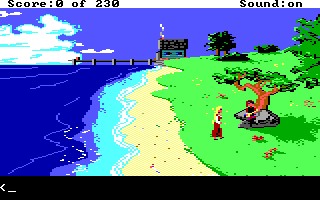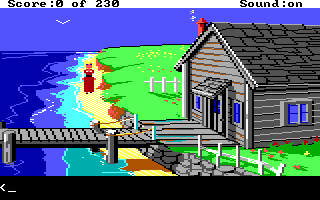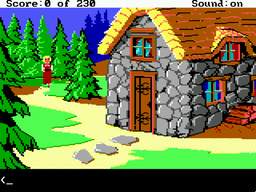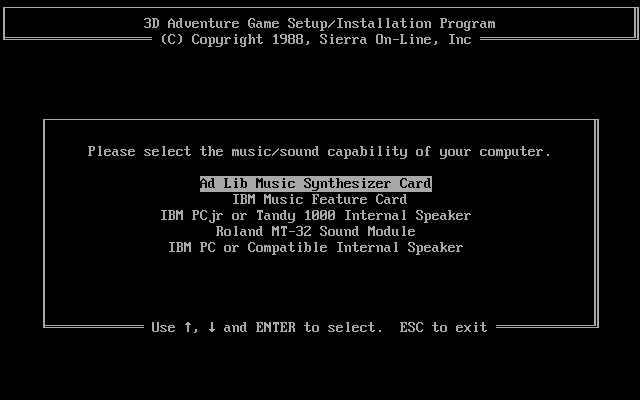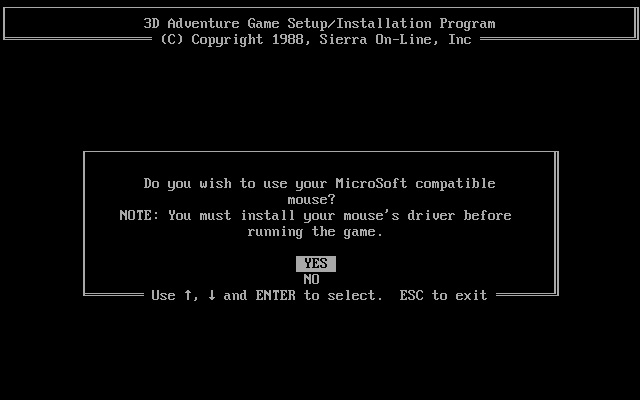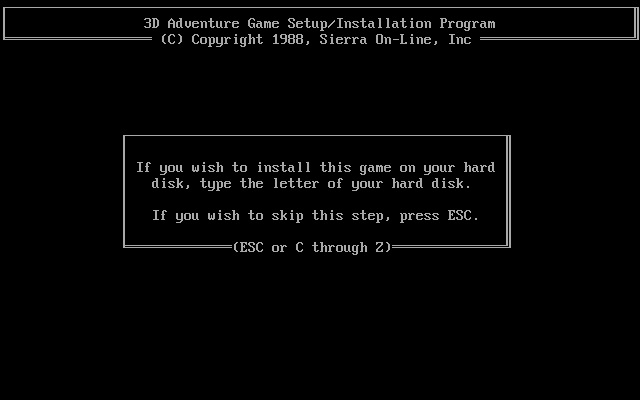 King's Quest IV (AGI)
King's Quest IV (AGI)
Released: 1988
Published by: Sierra On-Line, Inc.
Developed by: Sierra On-Line, Inc.
Credits: Roberta Williams, Ken Williams.
MT-32 "Old" Intro  Tandy 1000 (emulated) Intro  Ad Lib (emulated) Intro  |
MT-32 "Old" Preface  Ad Lib (emulated) Preface  |
| System Requirements | 8088 or 8086 and compatibles. 256K RAM required. DOS 2.11 or later. Hercules monochrome/CGA/EGA graphics supported. Audio support for PC speaker, Tandy, AdLib, CMS, Disney Sound Source, IBM Music Feature Card, and Roland MT-32. |
|---|---|
| Original Media | Six 5.25" 360 KB (DD) disks or three 3.5" 720 KB (DD) floppy disks. |
| Installed Size (MB) | - |
This AGI-interpreter version was released at the same time as the new SCI-interpreter version in order to ensure those with a low-end PC (8088 or 8086-based PCs) could still buy and play the new game. KQ4 was the only Sierra title to have both a native mode SCI version as well as AGI version (some titles that were originally made with the AGI engine were updated and released in SCI versions). This AGI version didn't sell many copies so is very rare. Sierra discontinued it within a few months of the game's August 1988 release. Both AGI and SCI versions are identical in gameplay apart from the SCI version having some additional parser responses.
From where can it be run?
From the original floppy disks or installed to hard disk (preferred). The INSTALL.EXE file, also used to configure hardware options, can be used to install the game to your hard disk.
Copy Protection
The game has manual copy protection. Upon startup you are prompted to enter a word from the manual on a given page, paragraph, and word number:


At the initial request for the word, if you press ALT-D, the following is displayed:

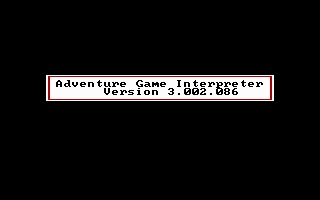
Hitting enter again displays a command prompt at the bottom of the screen. Here you have two choices. if you type in 'pirate' you get this screen:
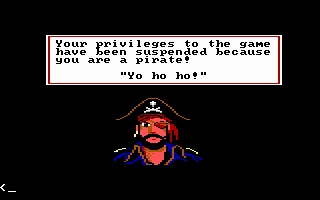
If you type in 'marble', the game begins!
Alternatively, you can be good and just enter the correct answer.
How to Setup
The game comes with a setup program. INSTALL.EXE, which guides you through the following options:-
1) Introduction:
2) Select graphics mode:
3) Select audio option:
4) Keyboard:
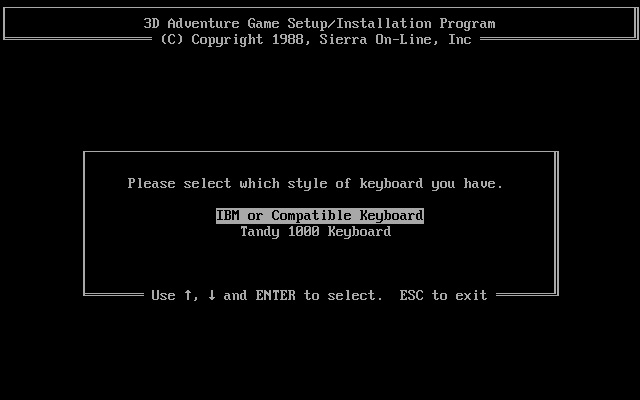
5) Joystick:
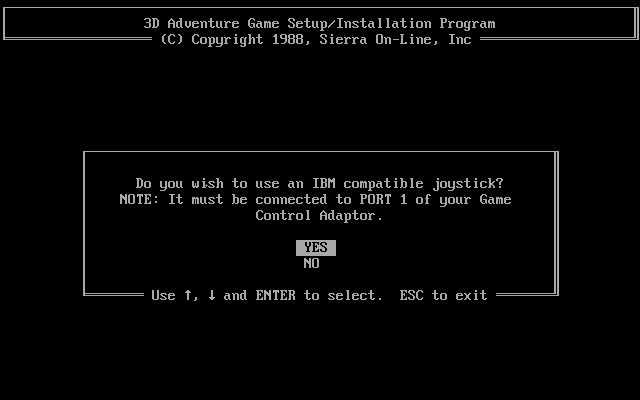
6) Mouse:
7) Install to Hard Disk:
To abort the setup/game startup and return to the command prompt, press ESC.
The game doesn't require any extended memory (XMS) or expanded memory (EMS) drivers to be loaded.
Note that King's Quest IV does not use any custom MT-32 patches, so if you don't have an MT-32 but do have a Sound Canvas such as an SC-55, SC-88 or SC-88 Pro, the music will sound just as good on these when put into MT-32 mode. To do so, on the SC-55 hold Instrument < while pressing the Power button to come out of Standby. At the prompt that reads "Init MT-32,Sure?" press the "All" button. On the SC-88 and SC-88 Pro, switch on the unit, press and hold the SELECT button on the bottom row and press Instrument <. At the prompt that reads "Init CM-64,Sure?", press "All".
Problems
Issue: I have connected my Roland MT-32 to my Sound Blaster's MIDI/Game port, but it's not working - I can't ever get the MT-32 to play the game music.
Cause: Sound Blaster cards do not have a Roland MPU-401-compatible MIDI port, which is required to play Sierra games in MT-32 mode.
Resolution: A third-party utility called MT32SB, written by Anders M Olsson, fixes this shortcoming for most Sierra games. Just copy the MT32SB.EXE file to your game directory
and run it. When prompted, enter your Sound Blaster's address (usually 220H). If it worked, you should see a new file called MT32SB.DRV appear in your game's directory, and a new option in the INSTALL program's music card list called "MT-32 / SoundBlaster MIDI". If for any reason the INSTALL program fails to display this new entry (this often occurs), you will need to edit the file INSTALL.HLP manually, and add these 2 lines to the bottom:
\\MT32SB.DRV
MT-32 / Soundblaster MIDI
Issue: My sound card's MIDI port is on a different address to the default 330H and I am not hearing game music.
Cause: Most Sierra games are hard-coded to send MIDI commands to address 330H. This is not a configurable option.
Resolution:If you have a sound card using a MIDI port address other than 330H (i.e. 300H), you can use this program to change the address in most Sierra DOS-based games released from 1990-1995 (King's Quest IV and later.) Benjamin Carter's MIDI Port Changer changes to any port number and has the familiar Sierra-style interface.
To Quit the Game
Press ESC to display the menu bar at the top of the screen. From here you can use the cursor keys to navigate through the menus, one of which is Exit Game.
Supporting Documents
Here are the original documents that came with the game:
And here are some aftermarket links:
Additional Files, Drivers and Utilities
This section includes any additional files, updated drivers (original and third-party) or utilities that help make the game a better experience.
- Tandy 3-voice patch for V2.00 - Forces Tandy 3-voice sound on a non-Tandy/PCjr machine. This of course is to be used with a Tandy compatible sound adapter on your regular IBM PC/XT/AT
Save Games
The save game data is stored in multiple files named KQ4SG.xxx, where xxx is an incrementing number from 000 and up. An additional file called KQ4SG.DIR also exists which most likely holds the list of save game numbers and their textual descriptions of the save games. The files are not readable/editable in a text-editor. You can manipulate these files as much as you like in DOS (overwrite them with new or backed-up ones, or delete them).
"Save game" files are not interchangeable between versions of the game, i.e. version 1.000.111 save game files will not work when restored in game version 1.006.004. If you try this, you are presented with a dialog that reads: "That game was saved under a different interpreter. It cannot be restored.".
Versions of the game known to exist
| Version | Date | Comments |
|---|---|---|
| 2.0 | 27th July 1988 | Comes with AGI3 intepreter v3.002.086. This version of the game has the "Pirate" (see Copy Protection above), "beam me" and "rap" Easter eggs. "Beam me" transports Rosella to a Star Trek-esque room with all of the development team present. |
| 2.2 | 27th September 1988 | Comes with AGI3 interpreter v3.002.086. No easter eggs. |
| 2.3 | 27th September 1988 | Comes with AGI3 interpreter v3.002.086. No easter eggs. |

